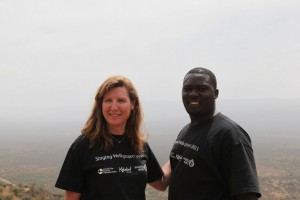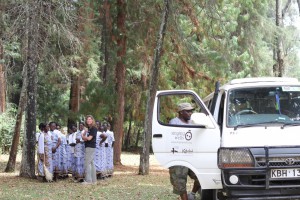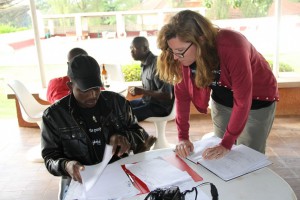Kathy Allen, trustee to the Abubilla Music Foundation, travelled with the Singing Wells team in March 2012 on the trip to record the music of the Kalenjin.
Here’s her report from the trip.
Kathy’s report from Kenya – March 2012
It was bit daunting coming into the Ketebul offices in the Go Down Art Centre on the first day. I had not met any of the people there and I wasn’t sure how I’d fit in. I need not have worried. Everyone was extremely welcoming and I could tell from the first day they were a professional group, had a common mission and were all dedicated. I enjoyed getting to know everyone and to hear what their views were on the music we were going to record. It certainly felt like an adventure and I was excited to get going.
The next day we set off and travelled up to Kitale, Northwest of Nairobi, in the Rift Valley. From the itinerary it looked like it should take us about five hours. I realise now that our itineraries were always quite optimistic but it didn’t really matter because the travel was almost as interesting as the destinations. It took eight hours to get to Kitale on two lane roads with more lorries than I could imagine. Jimmy’s written very accurately about the driving in his blogs. The country side was beautiful with mostly farm land, small villages and quite hilly.
I feel I had the best job on the trip because I got to interview all the groups about where they were from, what their clothing and adornment meant, what songs they sang and what they meant. I took advice from Victoria and spent quite a bit of time getting to know the people in the groups as well as the people in the Singing Wells group.
A few things struck me about the groups I interviewed. First they were for the most part not professional groups. They usually came from one village and the songs they sang came from everyday village life. Music is used as a form of communication and entertainment. The songs are used in various ceremonies such as weddings, births, funerals, harvesting and circumcision. They are also used as a way of passing on information and telling stories about the history of the tribes. Some songs were influenced by the Christian missionaries and had a gospel quality. Some of the stories in the songs were quite funny and I wish I could have understood all of the songs in more detail. The one singer who told his songs in detail was Ben Kisinja. For example his song about Sigerer, the bull, was actually more about how the miracle dog,  Jongjo, followed the scent of the stolen bull for hundreds of kilometres. I could imagine being a child in his village wanting him to sing that story over and over again. Our translator, Fifty Cows, was good at understanding the different languages but I feel details got lost in the translation. I wondered if being a woman asking the male elder about their songs was an issue. I found it easier to talk to the all women groups. They also gave me lots of handshakes, pats on the back and hugs which was really nice.
Jongjo, followed the scent of the stolen bull for hundreds of kilometres. I could imagine being a child in his village wanting him to sing that story over and over again. Our translator, Fifty Cows, was good at understanding the different languages but I feel details got lost in the translation. I wondered if being a woman asking the male elder about their songs was an issue. I found it easier to talk to the all women groups. They also gave me lots of handshakes, pats on the back and hugs which was really nice.
Second, the groups were all keen to be recorded. Most of them had never been recorded before or performed outside the tribe. They travelled long distances to get to the place we were recording them. The longest distance one tribe came was 150km by bus. Many of the other tribes had walked, some through the night, for up 60km to come meet us. They had practiced along the way and for hours before we recorded them. They were proud and wanted to show us their best performances. I really felt for them if they thought they hadn’t done something right in the performance. For instance if they started singing before the clapper board was out of the shot they had to start again. This unnerved and embarrassed them and they had to regroup before they could sing again. I felt it was important to talk to them before the performances to put them at ease, let them know what was going to happen and ask if they had any concerns or questions.
 Third, these groups came from tribes that have a history of conflict. Specifically I learned about how the Marakwet and Pokot fought each other for many years over cattle up to early 2000’s. That was not long ago yet these tribes came and sang together. They appeared to be at peace with each other although Fifty Cows felt it would have brought up memories of past conflicts. I saw various tribes intermingle and sing spontaneously with each other after their performances. There was also conflict in 2007 in the Rift Valley, in particular in Eldoret where we spent two nights. Some of the people I spoke to felt strongly that music was a way of bringing tribes together. Often their songs were quite similar to each other and they could understand each other through music.
Third, these groups came from tribes that have a history of conflict. Specifically I learned about how the Marakwet and Pokot fought each other for many years over cattle up to early 2000’s. That was not long ago yet these tribes came and sang together. They appeared to be at peace with each other although Fifty Cows felt it would have brought up memories of past conflicts. I saw various tribes intermingle and sing spontaneously with each other after their performances. There was also conflict in 2007 in the Rift Valley, in particular in Eldoret where we spent two nights. Some of the people I spoke to felt strongly that music was a way of bringing tribes together. Often their songs were quite similar to each other and they could understand each other through music.
I was impressed by how efficient and professional the Singing Wells group was. They worked well together to set up and break down their outdoor recording studio quickly. Each person had a specific role and took that role seriously. They are also enthusiastic about capturing the indigenous music. On top of the musical side of things they were great to travel with. When things went wrong like our car breaking down or microphones not working, they took it in their stride and came up with solutions. A great bunch of people.
 I thoroughly enjoyed the trip and heard a lot of wonderful music. In particular it was wonderful to see the fusion of old tribal music with contemporary music in the field and in the studio in Nairobi. The one thing that I learned on this trip was how important it is to talk to the tribes to get their histories but also to make them feel welcome and at ease. It would also be useful to have a debrief afterwards to see how they felt it went and if they have any comments. I hope to go back to other areas of East Africa to hear their stories and music but especially to meet the people.
I thoroughly enjoyed the trip and heard a lot of wonderful music. In particular it was wonderful to see the fusion of old tribal music with contemporary music in the field and in the studio in Nairobi. The one thing that I learned on this trip was how important it is to talk to the tribes to get their histories but also to make them feel welcome and at ease. It would also be useful to have a debrief afterwards to see how they felt it went and if they have any comments. I hope to go back to other areas of East Africa to hear their stories and music but especially to meet the people.
Kathy Allen
March 2012

